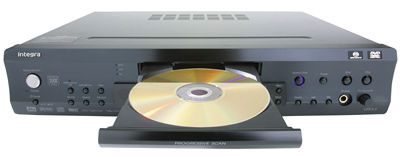Integra DPS-8.3 universal player

The Integra—priced, like most universal players, at $1200—provides a full list of features, including two component outputs, 3:2 pulldown correction, progressive output, bass and speaker management, and numerous video adjustments that can be saved and applied to individual DVDs.
The list of formats this THx Ultra player supports is extensive: DVD-Video, DVD-Audio, DVD-R/RW, SACD (2- and 5.1-channel), CD, 24/96 CD, CD-R/RW, and MP3. The DPS-8.3 also provides its own internal decoders for Dolby Digital, DTS, and certain MP3 recordings, which for most people is a redundant feature; almost every receiver and processor made in recent years provides Dolby Digital and DTS decoders.
Inside and Out
The DPS-8.3's video digital-to-analog converters run at 12 bits/108MHz. Among the DPS-8.3's peers, only the Sony DVP-N999ES offers a higher-resolution video DAC (14/108). On the other hand, the Sony provides a 24-bit/96kHz audio DAC, while the Integra's is 24/192. The highest-level DVD-Audio discs require that, but since Sony doesn't support DVD-A, its player doesn't need such a high-sample-rate converter.
The handsome, all-black DPS-8.3 shares its curious faceplate (and much of its internal circuitry) with several earlier Integra products. It looks as if Onkyo has duplicated the entire remote control, with all its buttons and features, on the player's front panel—21 buttons and controls in all. There's nothing wrong with this—maybe you can't find your remote, or the batteries die at a critical moment. The problem is that the labels denoting which button does what are so small and faint that they are barely readable. I can understand Integra's problem: Big, bold lettering under every control would make the DPS-8.3's front panel look like the controls of a Boeing 757.
Still, the DPS-8.3 is well-designed, with several thoughtful features, including one that offsets the faint labeling: When you turn the machine on, a soft, blue backlight highlights the disc tray's Open/Close button. Once a disc is inserted and the drawer is closed, the backlight turns off and the Play and Stop buttons are backlit instead. Very nice.

Other features seem pointless. For example, a label display lights up whenever the onscreen menu system is in use. The label says "GUI," for graphical user interface. But if the onscreen display is on, wouldn't you know?
The DPS-8.3 is heavy at 11 pounds, in part because it has two power supplies, one each for the digital and analog signal paths. (Although weight is not a particularly meaningful measure, the heaviest combi player I've encountered was the Sony DVP-S9000ES, the company's last-generation player, which weighed 28 pounds.)
The DPS-8.3 presents a blank gray screen on your TV when not in use—less attractive than some of the logos and images that other players display, but safe; there's no chance of screen burn-in. When activated, the Integra's screen saver kicks in less than five minutes after the player is paused, rolling soft color bars slowly down the screen.
The programmable remote is excellent. Perhaps there are too many buttons; a user will need a good bit of practice to be able to find the appropriate button without searching. But the remote is fully backlit, and the labels showing what each button does are actually on the buttons, meaning this remote can be read in the dark. Not only that, key buttons—Play, Pause, Stop, Fast Forward, etc.—are shaped like the commonly used symbols for these functions, so you can feel them in the dark as well. Menus are navigated with a cursor button that works quite well, unlike those of some other remotes.













































